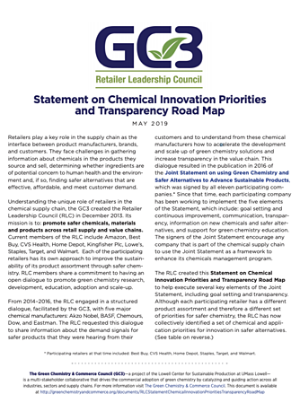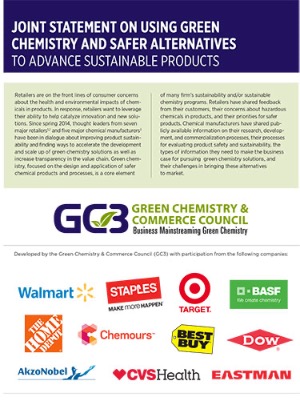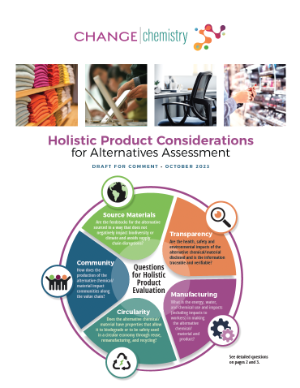Retailer Leadership Council (RLC)
Purpose
Retailers face challenges in gathering information about chemicals in the products they source and sell, determining whether ingredients are of potential concern to human health and the environment, and finding safer alternatives that are effective and meet customer demand.
We understand the unique role of retailers in the chemical supply chain, which is why we founded the Retailer Leadership Council (RLC) in December 2013. Its mission is to promote safer chemicals, materials and products across retail supply and value chains.
Current members of the RLC include: Amazon, Best Buy, CVS Health, H&M Group, Home Depot, Kingfisher, Lowe’s, Meijer, New Balance, Primark, Sephora, Staples, Target, The TJX Companies Inc, Ulta, Walgreens, and Walmart. These retail leaders are working proactively to accomplish the following:
-
Understand which chemicals of concern are in their products
-
Develop and implement chemicals policies/strategies
-
Engage their suppliers in identifying safer alternatives and improving chemicals management
-
Adopt safer alternatives that perform and are cost-effective
-
Educate their customers about safer products
The RLC is an active learning community, meeting bi-monthly via conference call and yearly in person at the Change Chemistry Innovators Roundtable. RLC members share best practices, challenges, and lessons learned from their experiences. The RLC engages with experts about the latest resources available to assist retailers in implementing their chemicals management programs. All members commit to have an open dialogue to promote green chemistry research, development, education and adoption.
You can find examples of some of our outputs below:
Holistic Product Considerations for Alternatives Assessment
In 2023, a sub-committee of the Change Chemistry Retailer Leadership Council formed to develop a question framework entitled Holistic Product Considerations for Alternatives Assessment. This framework is designed for use by a retail or brand manager who aims to make an informed decision before recommending or approving a change in a specific chemistry or class of chemicals.
RLC Statement on Chemical Innovation Priorities and Transparency Roadmap

In June 2019, the Green Chemistry & Commerce Council (GC3) released a statement developed by its Retailer Leadership Council (RLC) outlining chemical functions and priority product categories where innovation in safer alternatives is needed. It also developed a road map to encourage improvement in the supply chain and public transparency of chemical ingredients in consumer products.
The RLC Statement on Chemical Innovation Priorities and Transparency Roadmap builds on earlier work (see background below on the Joint Statement on using Green Chemistry and Safer Alternatives to Advance Sustainable Products). Although each participating retailer has a different product assortment, therefore, a different set of priorities for safer chemistry, the GC3 Retailer Leadership Council has now collectively identified a set of chemical function and application priorities for innovation in safer alternatives. The Transparency Road Map, a critical starting point to understanding chemical innovation needs, outlines best practices in the short-term (2019–20) and includes a longer-term vision that will need further development by the entire chemicals supply chain.
The Joint Statement

From 2014 - 2016, the RLC engaged in a structured dialogue, facilitated by the GC3, with five major chemical manufacturers: Akzo Nobel, BASF, Chemours, Dow, and Eastman. The RLC requested this dialogue to share information about the demand signals for safer products that they were hearing from their customers and to understand from these chemical manufacturers how to accelerate the development and scale up of green chemistry solutions and increase transparency in the value chain.
In 2016, the RLC released the Joint Statement on using Green Chemistry and Safer Alternatives to Advance Sustainable Products. The statement was unaniymously adopted by eleven participating companies. Since then, each participating company has been working to implement the five elements of the Statement. The signers of the Joint Statement encourage any company that is part of the chemical supply chain to use the Joint Statement as a framework to enhance its chemicals management program by addressing five elements:
-
Goal setting and continuous improvement
-
Communication
-
Transparency
-
Information on new chemicals and safer alternatives
-
Support for green chemistry education
Contact
If your company is a retailer that would like to join the RLC, or if you simply want to learn more about the RLC, contact:
Dr. Asli Tamer Vestlund
European Program Lead
asli@changechemistry.org

